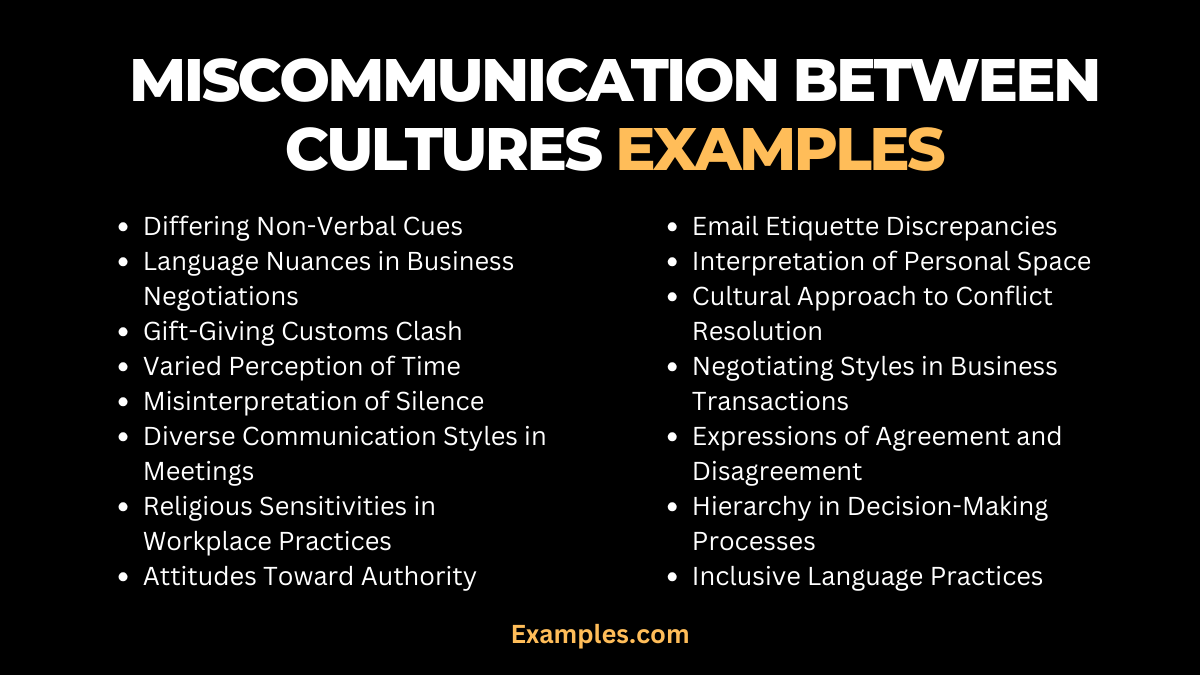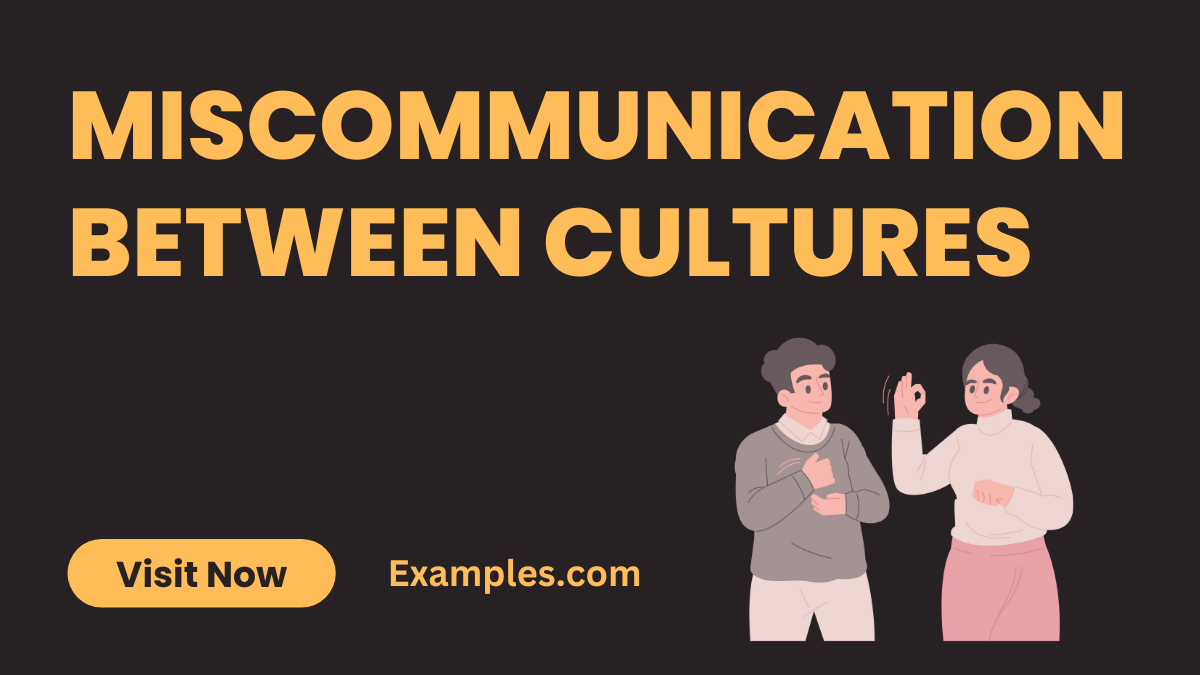19+ Miscommunication Between Cultures Examples
Embark on a global journey with our comprehensive guide on “Miscommunication Between Cultures: A Communication Examples Exploration.” This guide delves into real-life scenarios that illuminate the complexities of intercultural communication challenges. Navigate cultural nuances, explore communication pitfalls, and gain valuable insights on fostering effective global interactions. With practical tips and diverse examples, this guide serves as a roadmap for bridging cultural divides and enhancing cross-cultural communication for a more connected and harmonious world.
What is Miscommunication Between Cultures?

Miscommunication between cultures occurs when people from different cultural backgrounds fail to convey thoughts, ideas, or intentions clearly, leading to misunderstandings. In simple terms, it is the unintentional gaps in understanding that arise due to cultural differences, impacting effective communication and potentially causing conflicts, confusion, or tension. Navigating this phenomenon involves recognizing and addressing diverse communication styles, norms, and values to foster mutual understanding and harmony across cultural boundaries.
What is the Best Example of Miscommunication Between Cultures?

In this scenario, a Westerner offers a clock as a gift to an Asian colleague, unaware that clocks symbolize death in the recipient’s culture. The well-intentioned gesture results in discomfort and confusion due to the cultural significance attached to the gift. This detailed example underscores how miscommunication between cultures can arise from differing symbols and meanings, emphasizing the importance of cultural sensitivity and understanding in global interactions.
20 Miscommunication Between Cultures Examples

Embark on a global journey through diverse examples that unveil the intricacies of miscommunication between cultures. This curated collection offers valuable insights into common pitfalls, fostering a deeper understanding of intercultural dynamics for smoother global interactions.
- Differing Non-Verbal Cues: Confusion arises when hand gestures hold contrasting meanings; recognizing these differences ensures effective communication.
- Language Nuances in Business Negotiations: Miscommunication occurs when idiomatic expressions lead to misunderstandings; clear and precise language is crucial for successful negotiations.
- Gift-Giving Customs Clash: A clash emerges when cultural norms around gift-giving differ; understanding and respecting these norms prevent unintended offense.
- Varied Perception of Time: Conflicts arise when punctuality expectations differ; awareness and flexibility are key to navigating diverse cultural views on time.
- Misinterpretation of Silence: Silence is misinterpreted, leading to discomfort; recognizing diverse cultural attitudes towards silence prevents misunderstandings.
- Diverse Communication Styles in Meetings: Confusion arises when communication styles in meetings differ; adapting to varying preferences ensures effective collaboration.
- Religious Sensitivities in Workplace Practices: Miscommunication occurs when religious practices clash with workplace norms; fostering an inclusive environment mitigates cultural misunderstandings.
- Attitudes Toward Authority: Conflict arises when hierarchical attitudes vary; acknowledging and respecting diverse perspectives fosters harmonious collaboration.
- Email Etiquette Discrepancies: Miscommunication stems from differing email etiquette; awareness of cultural nuances ensures effective written communication.
- Interpretation of Personal Space: Discomfort arises when personal space expectations differ; understanding and respecting varied cultural norms prevent discomfort.
- Cultural Approach to Conflict Resolution: Conflicts escalate due to differing approaches to conflict resolution; finding common ground and understanding diverse methods promote resolution.
- Negotiating Styles in Business Transactions: Miscommunication occurs when negotiation styles clash; adapting strategies to accommodate diverse cultural preferences is essential.
- Expressions of Agreement and Disagreement: Confusion arises when expressions of agreement or disagreement are misunderstood; clear communication ensures mutual understanding.
- Hierarchy in Decision-Making Processes: Conflict emerges when hierarchical decision-making clashes with collaborative approaches; finding a balanced approach fosters effective decision-making.
- Cultural Views on Gender Roles: Miscommunication arises from differing views on gender roles; recognizing and respecting diverse perspectives promotes inclusive communication.
- Misaligned Business Card Etiquette: Confusion occurs when business card exchanges diverge in etiquette; adhering to culturally specific practices enhances professional interactions.
- Social Media Communication Differences: Miscommunication stems from varied social media communication styles; adapting content and tone to suit cultural norms ensures effective online interaction.
- Cultural Sensitivity in Humor: Conflicts arise when humor is misunderstood due to cultural differences; navigating diverse comedic sensibilities ensures respectful communication.
- Inclusive Language Practices: Miscommunication occurs when language is not inclusive; adopting inclusive language promotes understa
- nding and avoids potential offense.
- Differing Cultural Approaches to Feedback: Conflict arises when feedback styles differ; recognizing and adapting to diverse approaches enhances effective communication and collaboration.
Miscommunication Between Cultures for Students Examples
Explore miscommunication scenarios tailored for students navigating diverse cultural environments. This collection of examples provides insights into common pitfalls, offering valuable lessons on effective cross-cultural communication.
- Study Group Misinterpretation: Miscommunication occurs when cultural nuances affect study group dynamics; encouraging open dialogue prevents misunderstandings.
- Language Barrier in Classroom Collaboration: A language barrier leads to miscommunication during collaborative projects; utilizing clear communication tools enhances teamwork.
- Cultural Differences in Group Assignments: Conflicts arise when cultural norms impact approaches to group assignments; fostering an understanding of diverse working styles promotes successful collaboration.
- Misunderstood Classroom Participation: Cultural differences lead to misunderstandings in classroom participation expectations; clarifying expectations ensures an inclusive learning environment.
- Varied Interpretation of Academic Feedback: Miscommunication occurs when cultural backgrounds influence the interpretation of academic feedback; seeking clarification fosters a constructive learning environment.
Miscommunication Between Cultures at Workplace Examples
Navigate the complexities of cross-cultural communication within the workplace with these real-life examples. Gain insights into potential challenges and effective strategies for fostering a harmonious and diverse professional environment.
- Diverse Time Management Expectations: Confusion arises when cultural differences impact time management expectations at work; setting clear deadlines and expectations mitigates misunderstandings.
- Interpretation of Professional Attire: Miscommunication occurs when cultural perspectives influence the interpretation of professional attire; establishing a dress code guideline promotes workplace harmony.
- Approaches to Team Building: Cultural differences affect approaches to team building; understanding diverse preferences enhances the effectiveness of team-building initiatives.
- Cultural Sensitivity in Communication Channels: Miscommunication stems from varied preferences in communication channels; adapting to diverse communication styles ensures effective workplace communication.
- Conflicting Views on Work-Life Balance: Conflicts arise when cultural perspectives clash on work-life balance; fostering an inclusive approach accommodates diverse views and promotes employee well-being.
How can cultural miscommunication be avoided?
Cultural miscommunication can be navigated effectively by implementing proactive strategies that foster understanding and bridge cultural divides. Here’s a comprehensive guide with actionable points:
- Cultural Sensitivity Training:
- Provide cultural sensitivity training to enhance awareness of diverse customs and communication styles.
- Encourage Open Communication:
- Foster an environment where individuals feel comfortable expressing cultural differences and seeking clarification.
- Utilize Interpreters and Translation Services:
- When language barriers exist, use professional interpreters and translation services for clear communication.
- Clarify Expectations and Norms:
- Clearly communicate expectations and cultural norms within the workplace or educational setting.
- Promote Inclusive Language:
- Use inclusive language that respects diverse backgrounds and avoids unintentional offense.
- Establish Clear Communication Channels:
- Define clear communication channels and preferences to ensure information is relayed accurately.
- Adapt to Non-Verbal Cues:
- Understand and adapt to diverse non-verbal cues to avoid misinterpretations in various cultural contexts.
- Encourage Empathy and Perspective-Taking:
- Foster empathy by encouraging individuals to understand and appreciate different cultural perspectives.
- Provide Cultural Resources:
- Offer accessible resources such as cultural guides or mentorship programs to facilitate cross-cultural understanding.
- Cultivate a Diverse Leadership Team:
- Ensure diversity in leadership positions to promote inclusive decision-making and cultural awareness.
By incorporating these strategies, organizations and educational institutions can create an environment that minimizes cultural miscommunication and fosters harmonious interactions.
How does culture affect miscommunication?
Cultural nuances play a pivotal role in shaping communication styles, leading to miscommunication in diverse scenarios. Here’s a concise guide highlighting the impact of culture on miscommunication:
- Language Variances:
- Differing language structures and idioms can lead to misunderstandings.
- Cultural nuances in language expressions may convey unintended meanings.
- Non-Verbal Communication:
- Varied interpretations of gestures, facial expressions, and body language contribute to miscommunication.
- Cultural differences in eye contact and personal space influence communication dynamics.
- Communication Styles:
- Direct vs. indirect communication varies across cultures, impacting clarity and understanding.
- High-context vs. low-context cultures influence the depth of information provided in communication.
- Social Hierarchy:
- Divergent views on authority and hierarchy affect how individuals communicate in different cultures.
- Respect for authority may influence the willingness to express opinions or concerns.
- Time Perception:
- Varied perspectives on punctuality and time management contribute to miscommunication.
- A focus on past, present, or future orientation influences expectations in planning and deadlines.
- Conflict Resolution Approaches:
- Cultural differences in conflict avoidance or confrontation impact how disagreements are addressed.
- Some cultures value direct communication, while others prefer indirect or harmonious resolution.
- Cultural Norms and Taboos:
- Unfamiliarity with cultural norms and taboos can lead to unintentional offense.
- Awareness of acceptable behaviors in different cultures is crucial for effective communication.
- Gender Roles and Communication:
- Differing cultural perspectives on gender roles influence communication dynamics.
- Stereotypes and expectations regarding communication styles for men and women vary across cultures.
Understanding these cultural influences enhances awareness and facilitates effective cross-cultural communication, minimizing the risk of miscommunication in diverse global interactions.
Tips for Effective Cross-Cultural Communication?
Navigating the intricacies of cross-cultural communication requires sensitivity and awareness. Here are essential tips to foster effective communication and mitigate miscommunication between cultures:
- Cultural Sensitivity:
- Understand and respect diverse cultural norms, values, and customs.
- Be aware of potential differences in communication styles and preferences.
- Active Listening:
- Pay close attention to verbal and non-verbal cues.
- Seek clarification when needed to ensure accurate understanding.
- Adaptability:
- Be flexible in your communication approach based on cultural contexts.
- Adapt your communication style to suit the preferences of the other party.
- Clear and Concise Communication:
- Use simple language to convey your message.
- Avoid jargon and complex expressions that may be misunderstood.
- Mindful Use of Humor:
- Be cautious with humor, as cultural interpretations may vary.
- Choose inclusive and universally understandable humor when appropriate.
- Awareness of Non-Verbal Communication:
- Understand the significance of gestures, body language, and facial expressions.
- Be mindful of potential misinterpretations of non-verbal cues.
- Build Relationships:
- Invest time in building relationships to establish trust.
- Foster a collaborative and inclusive atmosphere for effective communication.
- Cultural Training:
- Engage in cultural training programs to enhance your cultural awareness.
- Seek opportunities for continuous learning about different cultures.
By incorporating these tips into your approach to cross-cultural communication, you can minimize miscommunication and create an inclusive and collaborative environment across diverse cultural landscapes.
In conclusion, this comprehensive guide sheds light on the intricacies of miscommunication between cultures. Through real-life examples and practical insights, it illuminates the challenges and offers strategies for fostering effective cross-cultural communication. By embracing cultural sensitivity and employing adaptive communication practices, individuals and organizations can bridge gaps, cultivate understanding, and navigate diverse global interactions with proficiency and harmony.



